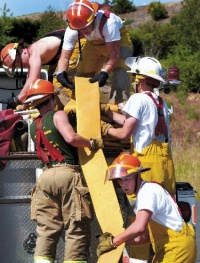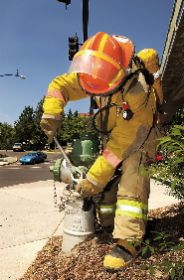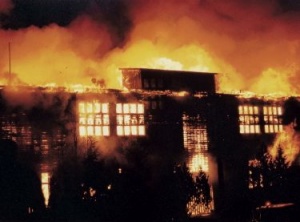Personal tools
Help
Tools
Class Notes
- Do you have news for fellow WSU alumni and other readers of Washington State Magazine? Send us your class note.
Our Story
written by alumni, faculty and friends.
NOTE: THIS IS A LEGACY SITE AND IS NOT REGULARLY MAINTAINED
Views
On Call: Student firefighters protect their campus
From Our Story
By Pat Caraher
Photography by Shelly Hanks
FromWashington State Magazine, Winter 2003/04
Given the order, four quickly enter the back door single-file. Visibility is near zero. Inside they immediately drop to their knees. The leader crawls to his right, careful always to keep his right hand on the wall as a point of reference. Each man holds on to the boot heel of a colleague ahead. A sweep of both floors takes less than 10 minutes. The "victims"-two dummies-are found and evacuated.
"There's no substitute for a 'live fire' exercise-the heat and the smoke, navigating furniture and stairs," says Bob Jarosch, training officer with the WSU and Pullman fire departments.
Firemen from both departments, along with volunteers from Whitman County Rural Fire District 12, participated in the drills over three nights in January. For the exercise, the fires were controlled-straw torched in barrels throughout the University-owned house near the coliseum. A week earlier, firefighters completed a walk-through, with attention to procedures and safety.
"You used to just come off the street to fight a fire," rural fire chief Lester Erwin says. "Now things have changed so much . . . the hours of training required." Student firefighters complete 150 hours to become emergency medical technicians (EMTs), if not already certified.
WSU and Pullman departments share responsibility for any fire on or off campus, or a mass casualty incident-for example, at the Pullman-Moscow Airport. A contract inked by the city and University in 2001 provides expanded, more cost-efficient service to the campus and community. Under the pact, veteran Pullman fire chief Pat Wilkins added the WSU Fire Department to his responsibilities.
He describes the 15 student firefighters as "the backbone" of the WSU department. They support five full-time firemen. At least two men are needed on an ambulance run, three on a fire call. A cardiac arrest case typically requires a five-man team-two permanent staff plus three student firefighters/EMTs.
"The students are a valuable asset," Wilkins says. "They are here as dedicated students, but also provide service 24/7 on a shift basis for the WSU Fire Department."
WSU is one of a handful of four-year colleges and universities nationwide that rely heavily on full-time student firemen and EMTs. The University of Alaska, Fairbanks and the University of California, Davis are the only others Wilkins knows of in the western United States.
Student firefighters live two to a room in the campus fire station. Each semester they elect a resident captain from their ranks. During the week, five three-man teams fill 14-hour shifts, 6 p.m. to 8 a.m. When not attending WSU classes, they return to the station and are on call. A minimum of one permanent staff, plus a student engine driver and two fightfighters/EMTs respond to all alarms around the clock.In 2002, the WSU fire station handled 387 fire calls and 282 requests for EMTs. The EMTs work all major WSU athletic events on campus, plus some events in the coliseum, like concerts and commencement. They deal with broken arms and legs, twisted ankles, sprains, and concussions. Some of the injuries result from varsity athletic games and practices, or intramural sports. Calls for assistance also involve detoxification, heart attacks, strokes, seizures, and falls.
According to a Pullman Herald account, student firemen at Washington State College date back to 1922-23, "when nine students manned the pumps." In the early '20s they lived in a metal shed attached to the rear of College Hall. In response to calls, they pulled a rickshaw-like fire cart across campus lawns and fields.
The college purchased its first fire truck, a Mitchell, in 1925, about the time the fire station was being established in a mechanical building on the present site of Daggy Hall-at the top of Engineering Hill. The current three-bay station across from the Compton Union Building was built in 1962.
The campus has experienced a number of significant fires. In the spring of 1949, a major portion of a wing of North House, one of the two-story World War II-vintage student residence halls known on campus as "Cardboard Castle," burned down.
An April 4, 1970 blaze destroyed 10,000 seats in the south grandstands at Rogers Field-now Martin Stadium-causing nearly $300,000 damage. The arson fire occurred during spring vacation, when only four firemen were on duty. The wood grandstands burned for three hours. That blaze was the impetus for increased staffing levels, particularly for the overnight shift.
More than 400 students have supported their education as WSU firefighters. Competition and qualifications are stiff. In spring 2002, 48 applicants sought three positions. On average, five firefighters graduate each May. Because of the extensive training, students must commit to a minimum of two years. Two to three women typically apply each year. Rigorous physical requirements eliminate many candidates, male and female alike. A woman passed the physical fitness test in 1997, but was hired by the Vancouver Fire Department before she could go to work at WSU.
Resident student captain Brent Olson was a WSU firefighter for three years, while pursuing dual degrees in criminal justice and sociology."This [fire fighting] is always what I wanted to do," he said last May between shifts. Two uncles and a cousin are firemen. He's tested with Tualatin Valley [Oregon] Fire and Rescue, the first step in "almost a year-long" hiring process. Four years ago, during a summer clinical rotation as an emergency room EMT at St. Vincent Hospital in Portland, he participated in the delivery of a baby in the hospital's doorway.
Olson helped fight the October 2001 fire that claimed Pullman's historic, two-story Corner Drug Store. Firefighters fought the blaze for nearly five hours. During the ordeal, the importance of the training he received, attention to safety, and service, was driven home.
"Sometimes you aren't at the top of your game. On those days, I say 'I'm not here for myself. I'm here for everyone.' That brings me back into focus," he says.
"You get to know the people you work with well. You rely on them. If I were to go down, they'd pull me out. We take that seriously, although it goes unsaid a lot of the time."
Our Story site map
Our Story main page | Our Story categories | Help Desk
Contact | Give | Advertise
Washington State Magazine | Washington State University | Class Notes
Our Story is coordinated by
In partnership with
Our Story and Washington State Magazine are publications of Washington State University. All rights reserved.
P.O. Box 641227, Washington State University, Pullman, WA 99164-1227 USA | wsm@wsu.edu, 509-335-2388
Accessibility | Copyright | Policies



